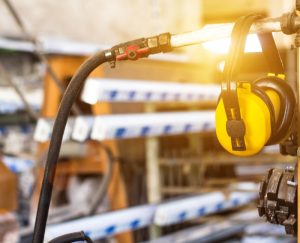Back to Basics is a weekly feature that highlights important but possibly overlooked information that any EHS professional should know. This week, we examine how to reduce risks from noise exposure in the workplace.
In nearly every industry, there are workers at risk for work-related hearing loss. It’s among the most common work-related illnesses thanks to the many occupational noise hazards workers face each day.
The National Institute for Occupational Safety and Health (NIOSH) provides guidelines and recommendations for employers and workers to help prevent hearing loss. Prevention is important because:
- Almost all work-related hearing loss is permanent and can have a profound impact on quality of life
- As hearing loss gets worse, hearing and understanding others becomes increasingly difficult
- Hearing loss is associated with cognitive decline and heart problems, such as high blood pressure and heart disease
- Hearing loss can lead to loss of enjoyment
- Ringing in the ears (i.e., tinnitus), which often occurs along with hearing loss, can disrupt sleep and concentration and is associated with depression and anxiety
- Hearing loss can impact safety at home and on the job
- Income is typically lower among workers with hearing loss
Prevention Strategies
To prevent work-related hearing loss, find out if the noise in your work space is hazardous. If you need to raise your voice to speak with someone at arm’s length, the noise is likely at a hazardous level. You can check the noise level using a sound level meter app on your phone or ask your safety manager or supervisor to check the noise levels in your workplace, making sure they are below 85dBA.
You can reduce your noise exposure by doing the following:
- Take a break from noisy activity
- Reduce noise at the source by using quieter equipment and keeping equipment well maintained and lubricated
- Enclose the source of the noise or put a barrier between you and the source
- Increase the distance between you and the source of the noise
- Reduce your time in noisy areas
- Always wear hearing protection in noisy areas
- If you are listening to music or something else, keep the volume at a safe level and only listen in areas that are not noisy
Reduce or stop exposure to chemicals that may damage your hearing. You can do this by using a less-toxic or non-toxic chemical. Wear gloves, long sleeves, and eye protection, and wear a respirator or other protective equipment, as appropriate. And read and follow all chemical safety instructions.
NIOSH provides recommendations for hearing loss prevention practices and the rationale behind in two publications, the Criteria for a Recommended Standard: Occupational Noise Exposure and Preventing Occupational Hearing Loss—A Practical Guide. Visit the University of Washington DEOHS School of Public Health for more information on how to assess and improve your occupational hearing loss prevention program, including a hearing loss prevention program checklist.

